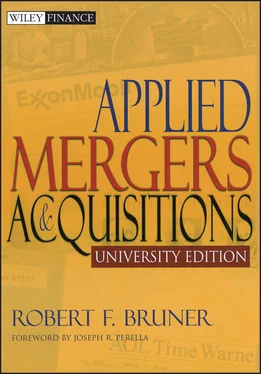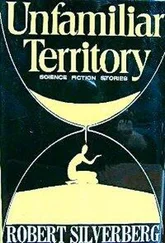*Significant at the 0.99 level or better.
†Significant at the 0.90 level.
‡Significant at the 0.95 level.
Third, firms selling assets tend to suffer from lower profitability or high leverage . Lang et al. (1995) concluded, “Management sells assets to obtain funds to pursue its objectives when alternative funding is either too expensive given its objectives or unavailable…. A successful sale means that the firm received enough money to make the sale worthwhile…. Firms selling assets typically are poor performers and they are more likely to pay out the proceeds when they find it difficult to service their debt.” (Page 22)
Research on the Profitability of Carve-outs, Spin-offs, Split-offs, and Tracking Stock
The general finding is that carve-outs, spin-offs, and tracking stock are neutral to beneficial for shareholders. Exhibits 6.17and 6.18summarize studies of the event returns associated with spin-offs and carve-outs; these are generally profitable to investors. Exhibit 6.19on page 164shows that tracking stock is value neutral to slightly positive for investors.
Research amplifies some of the insights. First, the investment behavior and financial performance of spun-off units improves following the spin-off. Gernter, Powers, and Scharfstein (2002) found that spun-off units tended to cut investment in unprofitable businesses and increase investment in profitable industries. Chemmanur and Paeglis (2001) found material increases in the price-earnings and price-sales ratios for parents and subsidiaries as a result of the transactions. Cusatis, Miles, and Woolridge (1993) documented significant returns over the longer term following spin-offs. Hurlburt et al. (2002) found that sales, assets, and capital expenditures of carved-out subsidiaries grew significantly faster than industry peers in the first year after the transaction; but the parent firm shrank. Ahn and Denis (2001) reported that diversified firms improved their investment efficiency and eliminated the diversification discount following spin-offs. In contrast, Haushalter and Mikkelson (2001) found no material improvement in long-term performance following tracking stock or carve-outs.
Second, relatedness matters in the choice of transaction. Chemmanur and Paeglis (2001) found that carve-outs and spin-offs tend to involve business units that are less related to the core than do tracking stocks. McNeil and Moore (2001) reported that announcement returns are larger at the spin-off of unrelated businesses than related businesses.
Third, the findings are consistent with benefits of increased focus. Hite and Owers (1983), Schipper and Smith (1983), Daley, Mehrotra, and Sivakumjar (1997), and Desai and Jain (1998) argue that spin-offs resolve “information asymmetry” problems—these arise from the complexity of multidivisional firms and the lack of transparency for investors to monitor the managers. Krisnaswami and Subramaniam (1999) find that firms undertaking spin-offs have higher levels of information asymmetry and that these problems decrease after the spin-offs. Best, Best, and Agapos (1998) find that securities analysts significantly increase their short-term earnings forecasts after spin-offs. Daley, Mehrotra, and Sivakumar (1997) find significant value creation around cross-industry spin-offs (rather than same-industry spin-offs). Vijh (2000) reports higher carve-out returns when the subsidiary is in a different two-digit SIC code from the parent. Veld and Veld-Merkoulova (2002) report significantly higher returns at spin-offs that are focus-increasing.
EXHIBIT 6.17 Summary of Studies of Market Returns to Parent and Subsidiary Shareholders at Spin-Offs
| Panel A: Returns to Shareholders of Parent |
| Study |
Cumulative Abnormal Returns at the Event |
Cumulative Abnormal Returns after the Event |
Sample Size |
Sample Periods |
| Davis, Leblond (2002) |
+2.92% *full sample +2.14% *industrial +3.87% *high tech (days –1,0) |
|
93 |
1980–1999 |
| Veld, Veld-Meruklova (2002) |
+2.66% *full sample +2.41% U.K. subsample +3.57% focus-increasing +0.76% not focus-increasing (days –1,+1) |
–0.41% full sample +5.20% focus-increasing –12.96% *not focus-increasing (months 0,+36) |
200 |
1987–2000 |
| Chemmanur, Paeglis (2001) |
+2.11% †(days –1,+1) |
|
19 |
1984–1998 |
| McNeil, Moore (2001) |
+ 3.53% *full sample +4.05% *unrelated +2.39% ‡related (days –1,+1) |
|
152 104 48 |
1980–1996 |
| Desai, Jain (1999) |
+ 3.8% |
+25.4% (3 yrs.) |
155 |
1975–1991 |
| Krishnaswami, Subramaniam (1999) |
+3.28% *full sample (days –1,+1) |
|
118 |
1979–1993 |
| Arbanell, Bushee, Raede (1998) |
|
+ 3.23% return to parents –0.86% return to spin-off (days –1,+60) |
245 |
1980–1996 |
| Best, Best, Agapos (1998) |
+3.41% *announcement date +2.9g4% *ex-date (day 0) |
|
72 63 |
1979–1993 |
| Daley, Mehrotra, Sivakumar (1997) |
+3.4% *full sample +4.3% *focus-increasing +1.4% not focus-increasing |
|
85 |
1975–1991 |
| Parrino (1997) Clinical study of one spin-off by Marriott Corporation |
+13.19% announcement date +41.12% five event dates |
|
1 |
1993 |
| Johnson, Klein, Thibodeaux (1996) |
+3.96% *full sample +5.42% *“back to basic” subsample |
N/A |
104 |
1975–1988 |
| Slovin, Sushka, Ferraro (1995) |
+1.3% |
N/A |
37 |
1980–1991 |
| Cusatis, Miles, Woolridge (1993) |
N/A |
+12.5% ‡(1 yr.) +26.7% ‡(2 yrs.) +18.1% (3 yrs.) |
146 |
1965–1988 |
| Vijh (1994) |
+2.9% ‡annct. date +0.79% completion date +3.03% ‡ex-date |
|
113 |
1964–1990 |
| Rosenfeld (1984) |
+5.56% *full sample |
|
35 |
1963–1981 |
| Schipper, Smith (1983) |
+2.8% |
N/A |
93 |
1963–1981 |
| Hite, Owers (1983) |
+3.3% |
+7.0% (5 mos.) |
123 |
1963–1981 |
| Miles, Rosenfeld (1983) |
+3.34% *full sample (days –1,0) |
22.9% (9 mos.) |
55 |
1963–1980 |
| Panel B: Returns to Shareholders of Subsidiary |
| Desai, Jain (1999) |
N/A |
+ 15.7% (1 yr.) +36.2% (2 yrs.) +32.3% (3 yrs.) |
155 |
1975–1991 |
| Cusatis, Miles, Woolridge (1994) |
N/A |
+4.5% (1 yr.) +25.0% (2 yrs.) +33.6% (3 yrs.) |
161 |
1965–1990 |
Unless otherwise noted, event date is announcement date of transaction.
*Significant at the 0.99 level or better.
†Significant at the 0.90 level.
‡Significant at the 0.95 level.
EXHIBIT 6.18 Summary of Studies of Market Returns to Parent and Subsidiary Shareholders at Carve-Outs
| Panel A: Returns to Shareholders of Parent |
| Study |
Cumulative Abnormal Returns at the Event |
Cumulative Abnormal Returns after the Event |
Sample Size |
Sample Period |
Notes |
| Vijh (2002) |
+1.94% *full sample +4.92% *sub is large +1.19% *sub is small (days –1,+1) |
|
336 |
1980–1997 |
Tests reject the asymmetric information hypothesis and support the divestiture gains hypothesis. |
| Hurlburt, Miles, Wool ridge (2002) |
+1.92% *full sample +2.10% *cross-industry –0.39% own industry |
|
185 153 30 |
1981–1994 |
Finds negative effect of carve-out announcement on rival firms. |
| Hogan, Olsen (2002) |
+11.42% carve-outs +16.53% IPOs matched (day 0) |
|
219 |
1991–2000 |
Carve-out returns are lower than returns in a matched sample of IPOs at offering. |
| Schill, Zhou (2001) |
+11.3% †(days –1,+1) |
|
11 |
2000 |
Focus on carve-outs of Internet subsidiaries. |
| Haushalter, Mikkelson (2001) |
+3.39% *full sample (days –2,+2) |
|
13 |
1994–1996 |
|
| Hulburt, Miles, Wool ridge (2000) |
+1.9% *(days –1,0) |
|
185 |
1981–1994 |
|
| Vijh (2000) |
+ 1.94% *full sample +2.25% *sub nor related industry +0.80% sub is related (days –1,+1) |
|
336 221 100 |
1980–1997 |
|
| Prezas, Tarimcilar, Vasudevan (2000) |
+5.83% *(day 0) |
7.61% *(6 mos.) 11.75% *(1 yr.) 21.07% *(3 yrs.) |
237 |
1986–1995 |
Carve-out returns are lower than returns in a matched sample of IPOs at offering and over the postoffering time periods. |
| Allen (1998) |
|
+33.2% HPR (0,12 months) +229.3% HPR (0,60) Holding period returns adjusted for industry returns |
1 |
1983–1995 |
Clinical study of 11 carve-outs by Thermo Electric |
| Allen, McConnell (1998) |
+2.12% *full sample +6.63% *proceeds paid out –0.01% proceeds are retained (days –1,+ 1) |
|
186 54 60 |
1978–1993 |
|
| Slovin, Sushka, Ferraro (1995) |
+1.2% ‡(days –l,0) |
|
32 |
1982–1991 |
|
| Klein, Rosenfeld, Beranek (1991) |
+2.75% *full sample |
|
52 |
1966–1980 |
|
| Schipper, Smith (1986) |
+1.83% ‡subsidiary –3.5% *parent (days –4,0) |
–0.5% subsidiary –1.40% parent (days +1,+40) |
76 |
1965–1983 |
|
| Chemmanur, Paeglis (2001) |
+1.96% ‡(days –1,+1) |
|
19 |
1984–1998 |
|
| Panel B: Returns to Shareholders of Subsidiary in Carve-Out |
| Hulburt, Miles, Wool ridge (1994) |
N/A |
+12.5% (1 yr.) +14.4% (2 yrs.) +24.7% (3 yrs.) |
80 |
1981–1989 |
|
Unless otherwise noted, event date is announcement date of transaction.
Читать дальше












